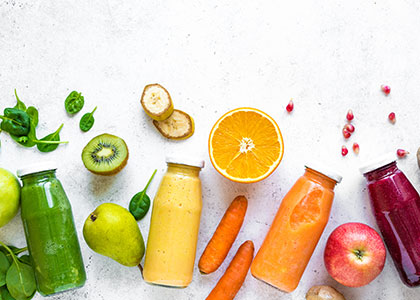Here's Why It's Important to Drink the Rainbow

People frequently ask our nutritionists if they can drink the famous Mean Green for the entire day while completing a juice fast. This juice is a delicious and powerful tool, but drinking it exclusively during your juice fast is NOT recommended!
Juice is an easy and fantastic way to increase and include many different nutrients, anti-oxidants and phytocompounds in your diet to enhance your energy, skin complexion, metabolism, immunity and everything else health-wise and the variety of color is paramount to this. But in order to get all these benefits, it’s important to consume a variety of color daily to maximize the results.
Each color represents a different group of nutrients, compounds and antioxidants. If you avoid certain colors by only drinking one type of juice, you will be limiting the nutrients you consume. The mantra ‘eat yourself a rainbow every day’ is one of my favorites and is a great guide to always follow whether you’re juicing or not.
Phytochemicals are substances found in plants that give them their smell, color and flavor. Each color is an excellent guide as to what specific nutrients and compounds that fruit or vegetable contains — here’s a look at the benefits you can expect to find in each produce color.
Red Produce
Red fruits and vegetables provide us with the very important compounds such as resveratrol, anthocyanins, lycopene, ellagic acid, quercetin, vitamin C, potassium and carotenoids. These nutrients act as powerful antioxidants and protect our cells from damage and are important for cardiovascular health, heart health, skin health, anti-cancer including breast and prostate. These nutrients help to protect our skin from sun damage as does green and orange.
Includes:
Grapes, tomatoes, watermelon, red peppers, cherries, beets, strawberries, raspberries, red currents, pomegranates, cranberries, goji berries.
Orange Produce
This produce has a high concentrations of flavonoids, carotenoids, particularly beta-carotenoids that are converted into vitamin A, which supports healthy mucus membranes of the digestive and respiratory tract and immune strength. These nutrients are also important for heart and eye health such as night vision. Other nutrients found in orange produce are folate, potassium and vitamin C.
Includes:
Pumpkin, sweet potato, carrots, butternut squash, acorn squash, orange, mango, apricots, nectarines, persimmons, peaches, cantoloupe (rockmelon), papaya, turmeric.
Green Produce
A majority of your fruit and vegetable consumption should be green — I often recommend 40-50 percent of your produce be green. Greens contain sulforaphane, magnesium, calcium, iron, lutein, zeaxanthin, potassium, Vitamin K, carotenoids, folate and other B vitamins, protein, lipoic acid, Vitamin C, chlorophyll and more. These nutrients are important for supporting liver detoxification, anti-cancer, eye health, heart health, immunity, blood clotting, electrolytes, energy, bone health, skin complexion and hormonal health.
Includes:
Kale, broccoli, spinach, chard, lettuce, collards, arugula, dandelion, bok choy, cabbage, cucumber, celery, Brussel sprouts, kiwi, apple, limes, peppers, pears, asparagus, snow peas, beans, and zucchini.
Yellow produce
Yellow produce is full of carotenoids, bioflavonoids and vitamin C, which all function as powerful antioxidants. These nutrients will help to support healthy skin, eyes, digestion and immune health. Every fruit and vegetable has its very own special nutrients such as bromelain in pineapple, limonoids in lemons and papain in papaya.
Includes:
Pineapple, golden beets, yellow peppers, golden kiwi fruit, grapefruit, corn, bananas, lemons, star fruit, summer squash, spaghetti squash and quince.
Purple Produce
You’ll find powerful antioxidant benefits to protect the cells from damage and to support the immune system in purple produce. It contains polyphenols, resveratrol and anthocyanins, that help to fight inflammation and provide anti-aging, skin, eye and anticancer benefits.
Includes:
Grapes, blueberries, purple carrots, radicchio, eggplant, red cabbage, red onion, figs, plums, radish, olives and prunes.
White Produce
White fruits and vegetables are important to include in the diet regularly due to their naturally occurring polyphenol content, which helps to support heart health via healthy cholesterol levels, blood pressure and reduces the risk of cancer. White foods also contain the nutrients allicin, quercetin, sulforaphane and potassium.
Includes:
Cauliflower, leeks, chicory (witlof), garlic, onions, parsnips, turnips, mushrooms, potato, fennel.